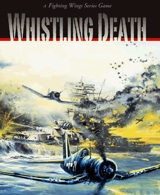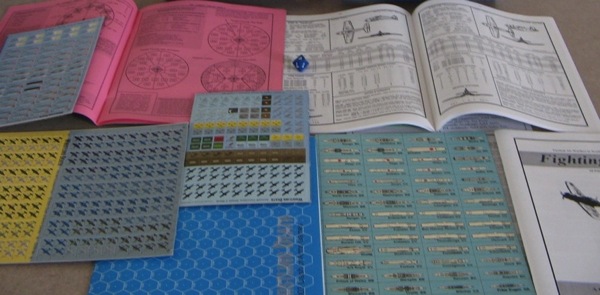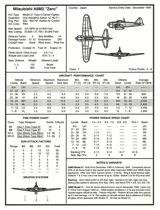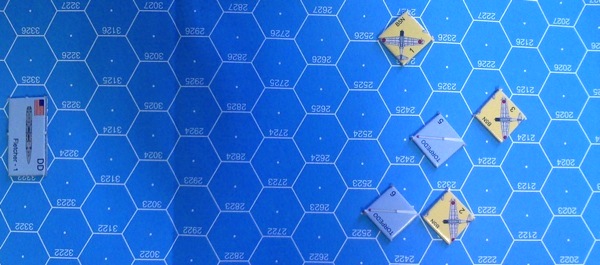Whistling Death: Tactical Air Warfare in the Pacific – Boardgame Review
 Whistling Death: WWII Air Warfare Over the Pacific, 1941 – 1945. A Fighting Wings Game Expansion. Boardgame. Publisher: Clash of Arms. Designer: J.D. Webster. $65.00
Whistling Death: WWII Air Warfare Over the Pacific, 1941 – 1945. A Fighting Wings Game Expansion. Boardgame. Publisher: Clash of Arms. Designer: J.D. Webster. $65.00
Passed Inspection: Beautiful counters. Solitaire scenarios included. Great background information. Tons of detail. Covers Tactical and Operational missions. Campaign rules. Great value for the money spent.
Failed Basic: Game rules can be overwhelming. Lots of chart flipping. Counters don’t quite line up with the die cutting.
It was Dec 8, 1941—Pearl Harbor had been attacked and war declared between Japan and America. Roger Nesmith, flying a P40E, was attacking Japanese planes strafing Clark Field in the Philippines when he and his wingmen were attacked by Japanese Zeros. Nesmith dived and closed rapidly with the A6M2 Zero piloted by Hiro Imagawa. They attacked at close range, head to head, and Imagawa, already an Ace pilot after his service in the Chinese theater, hit Nesmith’s P40 with a solid attack from his machine guns and cannons. The P40’s hydraulic system was damaged and its landing gear extended and locked down, seriously affecting the P40’s speed. Nesmith’s attack with the P40’s 50-caliber machine guns punctured Imagawa’s unprotected fuel tanks but, luckily for the Japanese pilot, didn’t start a fire. As Imagawa used his superior turn rate to left bank back towards Nesmith’s plane, Nesmith took advantage of his extra speed from the dive to execute a half loop, and the two planes exchanged fire again. This time Imagawa’s attack only did minor damage but Nesmith’s 50–cals tore in to the Zero. Its engine caught fire, and its structure began to fail. Imagawa bailed out and was captured by American soldiers. Nesmith landed hard back at Clark but survived for another day. He would make the Empire of the Rising Sun pay for Pearl.
{default}So ran my play-through of "Head-On Over Clark," an introductory scenario in Whistling Death, the third entry in the Fighting Wings World War II game series. The venerable Fighting Wings series has been around since 1993. The World War II tactical games Over the Reich and Achtung–Spifire! were sequels (prequels?) of sorts to J.D. Webster’s jet combat games Air Superiority and The Speed of Heat.
As stated in my review of the Fighting Wings micro-expansion Buffalo Wings, I have been aware of this game system since the early 1990s and had purchased all of the games but The Speed for Heat. As a "youngster" in the early 1990s (yeah, right), I had a great deal of trouble investing both the time and the mental energy to learn the game, as the rules are very complete and somewhat dense to read—almost like reading a tax code book or the rules to Advanced Squad Leader. But, this being said, after my review plays on Buffalo Wings, I decided to re-explore the uncut, full gaming system as found in Over the Reich and Achtung–Spifire! I started German, French and British campaigns and from that point on, I was hooked on this system. While I can see why I didn’t pursue learning the system back when it came out, I am deeply disappointed in myself that I didn’t persevere and master the highly detailed, wonderfully playable, but extremely challenging Fighting Wings system.

The box includes the rulebook, a scenario book, a book with data on over 40 airplanes and ships, a book of tables and charts and a handy "Quick Start" game to get you into the action fast.
Whistling Death is the Pacific Theater expansion to the Fighting Wings system. As such, it adds units from Imperial Japan and the United States Navy to the mix. It also adds extremely detailed navel warfare rules (but only to the extent that the ships and subs are targets for airborne attacks). The author of the system, J.D. Webster, has established an extremely active on-line support system and airplanes have been added that cover the Chinese theater and even night fighters in the Pacific!
Each unit is one airplane, ship or ground target. Each plane is rated for elements such as gun number, caliber and position, performance, power output at speed and altitude, defense factors including protection such as armored fuel tanks, speed, etc. Each turn is 4 seconds, and each hex on the map is equal to 100 yards.
 Each turn the players must plot their airplane’s speed, altitude, position, nose position (up, level or down), flight attitude (inverted, bank left, etc.) and acceleration/deceleration as well as turn rate on an aircraft spreadsheet. They then move their units on the map, with the player who rolled the lowest initiative moving first. While the hex movement is not preplotted, the players are still somewhat limited by how they have allocated their engine power, speed, turn rate and such. Combat involves the number and type of weapons each plane possesses, matched up with range and attack position. Then a percentile die is rolled and the results matched against a table. If a hit occurs, the type of weapon dictates the number of damage points done by the attack, plus the chances for a critical hit. The Critical Hit Charts provide a realistic feel to the attacks and definitely help to build the tension, as my example at the beginning of the review attests.
Each turn the players must plot their airplane’s speed, altitude, position, nose position (up, level or down), flight attitude (inverted, bank left, etc.) and acceleration/deceleration as well as turn rate on an aircraft spreadsheet. They then move their units on the map, with the player who rolled the lowest initiative moving first. While the hex movement is not preplotted, the players are still somewhat limited by how they have allocated their engine power, speed, turn rate and such. Combat involves the number and type of weapons each plane possesses, matched up with range and attack position. Then a percentile die is rolled and the results matched against a table. If a hit occurs, the type of weapon dictates the number of damage points done by the attack, plus the chances for a critical hit. The Critical Hit Charts provide a realistic feel to the attacks and definitely help to build the tension, as my example at the beginning of the review attests.
Whistling Death (one of the Japanese names for the F4U Corsair), features 2nd Edition rules for the Fighting Wings system. While the basics remain the same, there have been some changes from the original rules. One of the big changes is that a pilot can no longer fire on an enemy plane in the same round that he performs an "emergency turn," since he’s pulling in the range of 6gs. This changes my tactics somewhat. The rules are packed with more types of maneuvers and examples of each including very helpful charts showing how to perform loops and Immelmanns. A "flight proportions table" is a great aid for figuring out how flight attitudes modify the airplane’s speed. A rather interesting but somewhat unsettling change (for those used to the earlier games) is the inclusion of a percentage chart called the "Base Likelihood Table" which takes the place of individual "to hit" tables and others. This table is used (with specific modifications) for almost all items that are "left to chance."
A wonderful expansion of the game system’s navel rules is included to cover the greater predominance of navel air strikes found in the Pacific Campaign. Full rules are included for dive-bombing, torpedo attacks, anti-aircraft guns, flooding, carrier operations, etc. Data sheets for over 25 ships are included—everything from the mighty Yamato to navy landing boats and submarines are covered. Each data sheet includes charts of all anti-aircraft batteries on the ships. I only wish that Webster had gone the extra step and included extra rules for ship-to-ship combat in the game. While perhaps outside the scope of Whistling Death, it seems like an extra few pages would have allowed ship battles to occur while airplanes attacked the ships. Hint, hint, J.D.—how about another expansion? Hint, hint!!!

Nakajima B5N "Kates" send torpedoes streaking toward USS Fletcher.
Full campaign rules are included, as are what amount to two extra games should the player wish to use them as such: Tactical Scale Play in which players try to maneuver for favorable positions or just to spot enemy units and Operational Rules in which players run bombing missions and have to pay attention to weather, fuel considerations, ground and airborne radar, flak, etc.
These incredibly detailed and complete rules also include Kamikaze attacks, parafrag bombs, skip-bombing missions, night missions, weather and smoke considerations, multi-engine airplanes, and more.
The rules include a very handy and much-needed list of abbreviations and a full index and are fully backwards compatible with previous games in the series.
The box includes the rulebook, a scenario book, a book with data on over 40 airplanes and ships, a book of tables and charts and a handy "Quick Start" game to get you into the action fast.
 The scenario book includes a full history of the Pacific Campaign and over 90 solitaire and multi-player scenarios broken down into Flight Training, Introductory, Air-to-Air Combat, Air-to-Ground Combat, Air-Naval Combat and Mission Level Scenarios. Some of the scenarios can be played in 20 to 30 minutes; others, such as the massive Pearl Harbor scenario with 18 ships and 4 waves of Japanese planes, will take hours to complete.
The scenario book includes a full history of the Pacific Campaign and over 90 solitaire and multi-player scenarios broken down into Flight Training, Introductory, Air-to-Air Combat, Air-to-Ground Combat, Air-Naval Combat and Mission Level Scenarios. Some of the scenarios can be played in 20 to 30 minutes; others, such as the massive Pearl Harbor scenario with 18 ships and 4 waves of Japanese planes, will take hours to complete.
A 34" x 22" map of the ocean or blue sky is included. Unlike previous games in the series, the map is not double sided. It would have been nice to have a blue map and then a side with islands and jungle. Oh, well.
Also included are 320 full-color aircraft counters, 100 ground unit counters, 130 medium and large ship counters, some small ship counters, game markers and a 10-sided die.
There are still a few things that tarnish the game system. Even with the Quick Start rules, the game is a challenge to master. The rules are a little dry and could benefit from being less stuffily written. For example "Transition Decel: When A/C (aircraft) transitions from one flight attitude to another, they incur decel as if changing facing 30 degrees at the turn rate used for the transition for each step of flight attitude the A/C nose moved through." ("What was that part in the middle?" A Fish Called Wanda quote was needed and is requested here.) The counters, although very nice looking and easy to punch out, are cut slightly off-base so that when a plane is punched out, part of it is left on the neighboring counter (uuughhh). The Bomb/Torpedo Damage Data sheet is on the back of the Scenario Book instead of being included in the book of charts and tables. A better explanation of whether a given type of ship represents a hard or a soft target is needed for damage considerations, and more explanation is needed for critical hits to naval units.
Even with these minor dents in the game’s armor, Whistling Death is a fine addition to the Fighting Wings system and one of the best World War II air war games on the market.
Breaking News: another expansion is due out soon and it will not only cover the Russian Front but will include 3rd Edition Fighting Wings rules. I can hardly wait!
Armchair General Rating: 93%
Solitaire Rating: 4 out of 5
To learn more about Fighting Wings and the mind behind the rules, read Richard Martin’s exclusive Armchair General interview with J.D. Webster.
About the Author
A college film instructor and small business owner, Richard Martin has also worked in the legal and real estate professions, is involved in video production, film criticism, sports shooting and is an avid World War I and II gamer who can remember war games which came in plastic bags and cost $2.99 (he’s really that old)!


0 Comments
Trackbacks/Pingbacks